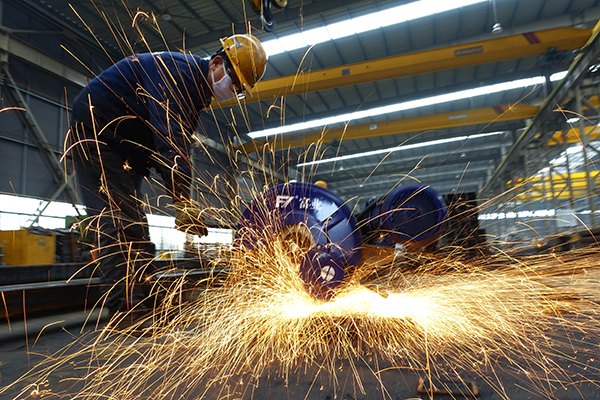
A workshop of Sanway Steel Building Co in Tengzhou, Shandong province. China is still forecast to need a large amounts of iron ore to make steel. In 2015, more than 40 percent of Rio Tinto Group's revenue came from China. (Photo/China Daily)
Global mining giant Rio Tinto Group is looking into opportunities for growth in uranium business, predicting an uptick in the industry driven by China's rising demand for the nuclear fuel.
"Uranium has been a tough business since the Fukushima nuclear disaster in Japan, but the uranium market will recover with new nuclear power plants coming on in China and other countries in the world," said Sam Walsh, chief executive of the company.
Rio Tinto has uranium-related operations in Australia and Namibia and potential projects in Canada after it completed the acquisition of Hathor Exploration Ltd, a uranium exploration company with assets in the Athabasca Basin region of Saskatchewan, in 2012.
"Currently, Canada's Hathor project is in drilling process, and it is very early in terms of development, but I think nuclear power is an important part of environmental solution for the world and it has a positive prospect in the future," said Walsh.
Uranium prices declined from more than $130 per pound to about $40 last year in the wake of the Fukushima crisis and temporary shutting of nuclear power plants across the globe.
Experts said though prices may remain depressed this year, it will see a big rebound to about $70 to $80 in the coming years as China, a major contributor to the growth in uranium demand, is embarking on a massive program to build about 110 nuclear reactors by 2030.
In 2015, more than 40 percent of the British-Australian mining giant's revenue came from China, the world's second-largest economy, and Walsh expects the share to continue to rise in the next three years.
That is because he is confident that the company's business will grow along with China's development.
"Analysts focused on domestic demand for the steel market, but they overlooked the country's capability for exports, especially in elaborate manufacturing sector."
Walsh's remarks came at a time when the world's second-largest miner has named its copper and coal group chief executive Jean-Sebastien Jacques to succeed him later this year.
Walsh, 66, who will retire from the current position on July 1, said that it is a good timing for the change of CEO, but it does not mean a shift in the company's strategy to continue to focus on low-cost and tier-one assets.
He said the price of iron ore, a key industrial metal seen as a proxy for demand in the global economy, is likely to keep a downward trend this year, but will see a rebound in 2017.
"We have seen prices drop but this is what we expected over time, and I expect as new tons come on (to market), the price will come down for this year," he said, adding the price will not get back to where it stood before.


















































